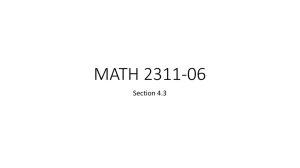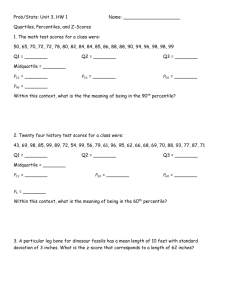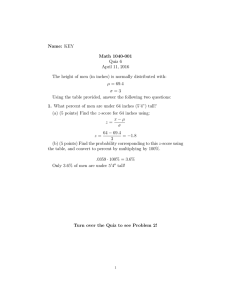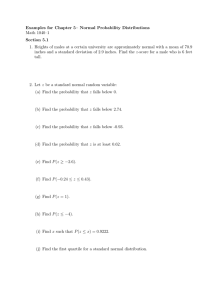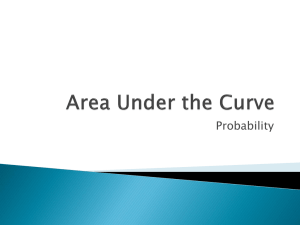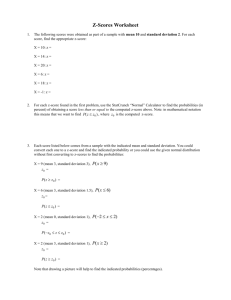Section 5.2, Normal Distributions: Finding Probabilities
advertisement
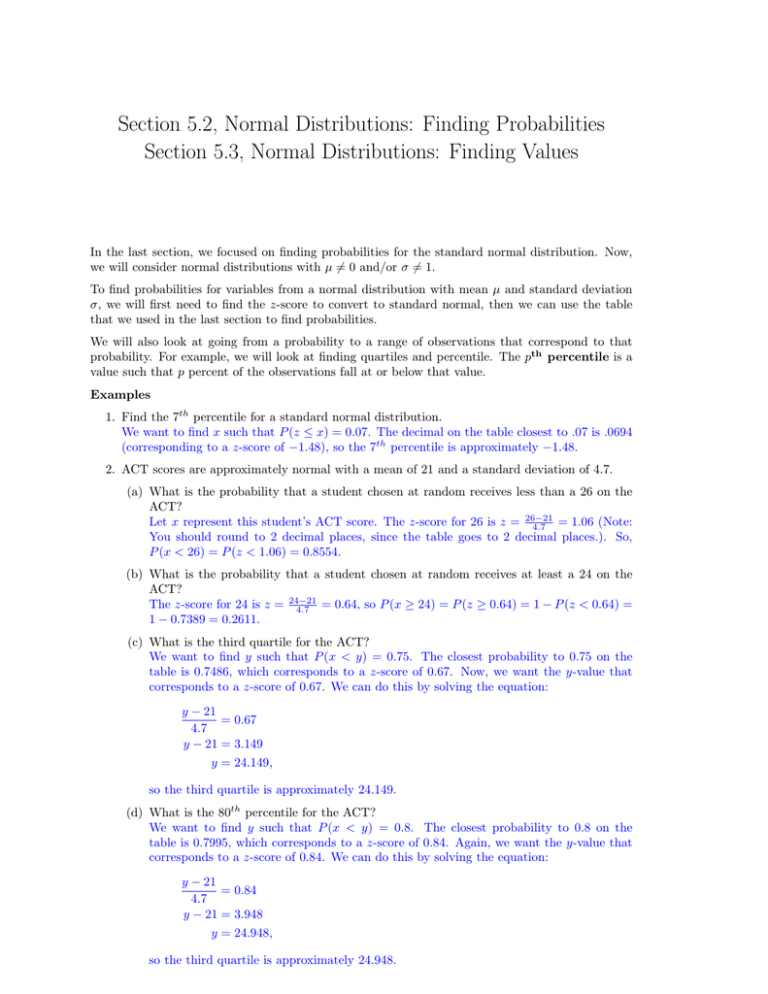
Section 5.2, Normal Distributions: Finding Probabilities Section 5.3, Normal Distributions: Finding Values In the last section, we focused on finding probabilities for the standard normal distribution. Now, we will consider normal distributions with µ 6= 0 and/or σ 6= 1. To find probabilities for variables from a normal distribution with mean µ and standard deviation σ, we will first need to find the z-score to convert to standard normal, then we can use the table that we used in the last section to find probabilities. We will also look at going from a probability to a range of observations that correspond to that probability. For example, we will look at finding quartiles and percentile. The pth percentile is a value such that p percent of the observations fall at or below that value. Examples 1. Find the 7th percentile for a standard normal distribution. We want to find x such that P (z ≤ x) = 0.07. The decimal on the table closest to .07 is .0694 (corresponding to a z-score of −1.48), so the 7th percentile is approximately −1.48. 2. ACT scores are approximately normal with a mean of 21 and a standard deviation of 4.7. (a) What is the probability that a student chosen at random receives less than a 26 on the ACT? Let x represent this student’s ACT score. The z-score for 26 is z = 26−21 4.7 = 1.06 (Note: You should round to 2 decimal places, since the table goes to 2 decimal places.). So, P (x < 26) = P (z < 1.06) = 0.8554. (b) What is the probability that a student chosen at random receives at least a 24 on the ACT? The z-score for 24 is z = 24−21 4.7 = 0.64, so P (x ≥ 24) = P (z ≥ 0.64) = 1 − P (z < 0.64) = 1 − 0.7389 = 0.2611. (c) What is the third quartile for the ACT? We want to find y such that P (x < y) = 0.75. The closest probability to 0.75 on the table is 0.7486, which corresponds to a z-score of 0.67. Now, we want the y-value that corresponds to a z-score of 0.67. We can do this by solving the equation: y − 21 = 0.67 4.7 y − 21 = 3.149 y = 24.149, so the third quartile is approximately 24.149. (d) What is the 80th percentile for the ACT? We want to find y such that P (x < y) = 0.8. The closest probability to 0.8 on the table is 0.7995, which corresponds to a z-score of 0.84. Again, we want the y-value that corresponds to a z-score of 0.84. We can do this by solving the equation: y − 21 = 0.84 4.7 y − 21 = 3.948 y = 24.948, so the third quartile is approximately 24.948. 3. A brand of cassette decks had a deck life that was normally distributed with a mean of 2.3 years and a standard deviation of 0.4 years. (a) What is the probability that the cassette deck will break down less than one year after purchase? 1 − 2.3 P (x < 1) = P z < = P (z < −3.25) = 0.0006 0.4 (b) What is the probability that the cassette deck will last for at least 3 years after purchase? 3 − 2.3 P (x ≥ 3) = 1 − P (x < 3) = 1 − P z < 0.4 = 1 − P (z < 1.75) = 1 − 0.9599 = 0.0401 (c) What is the 99th percentile for the life of these cassette decks? We want y such that P (x ≤ y) = 0.99. The closest probability on the table is 0.9901, occurring at z = 2.33, so y − 2.3 = 2.33 0.4 y − 2.3 = .932 y = 3.232, so the 99th percentile is approximately 3.232 years. 4. A pizza parlor franchise specifies that the average amount of cheese on a large pizza should be 8 ounces and the standard deviation should be 0.5 ounces. (a) What is the probability that a pizza chosen at random has less than 7.3 ounces of cheese? 7.3 − 8 = P (z < −1.4) = 0.0808 P (x < 7.3) = P z < 0.5 (b) What is the probability that a pizza has more than 8.95 ounces of cheese? 8.95 − 8 P (x > 8.95) = 1 − P (x ≤ 8.95) = 1 − P z ≤ = 1 − P (z ≤ 1.9) 0.5 = 1 − 0.9713 = 0.0287 (c) What is the probability that a pizza contains between 7.6 and 8.3 ounces of cheese? 7.6 − 8 8.3 − 8 P (7.6 ≤ x ≤ 8.3) = P ≤z≤ = P (−.8 ≤ z ≤ 0.6) 0.5 0.5 = 0.7257 − 0.2119 = 0.5138 (d) What is the probability that a pizza has exactly 8 ounces of cheese? Since this is a continuous distribution, the probability of taking an exact value is zero. (We can see this by noticing that P (x = 8) = P (8 ≤ x ≤ 8), so when we convert to z-scores and look up probabilities in the table, we’ll be subtracting the same number from itself.) (e) What is the least amount of cheese that can be on a pizza that will still place in the top 10% of cheesiest pizzas? We want y such that P (x > y) = 0.1, which is the same a y that satisfies P (x < y) = .9. 0.8997 is the closest probability to 0.9 on the table, so z = 1.28. Then, finding y, we solve: y−8 = 1.28 0.5 y − 8 = 0.64 y = 8.64 (f) Between what two values does the middle 70% of cheese lie? We first want y such that P (−y < z < y) = 0.7, and we will convert to the x value later. By symmetry, we will have 15% of the observations above y, and 15% below −y. This means that 85% of the observations are below y, so y satisfies P (x < y) = 0.85. 0.8508 is the closest probability on the table to this, which corresponds to a z-score of 1.04. Changing to a normal distribution with mean 8 and standard deviation 0.5, we get that the middle 70% of cheese lies between 8 − 1.04 · 0.5 = 7.48 and 8 + 1.04 · 0.5 = 8.52.

